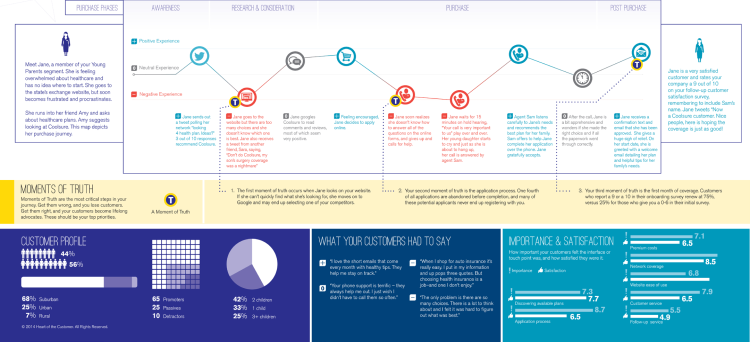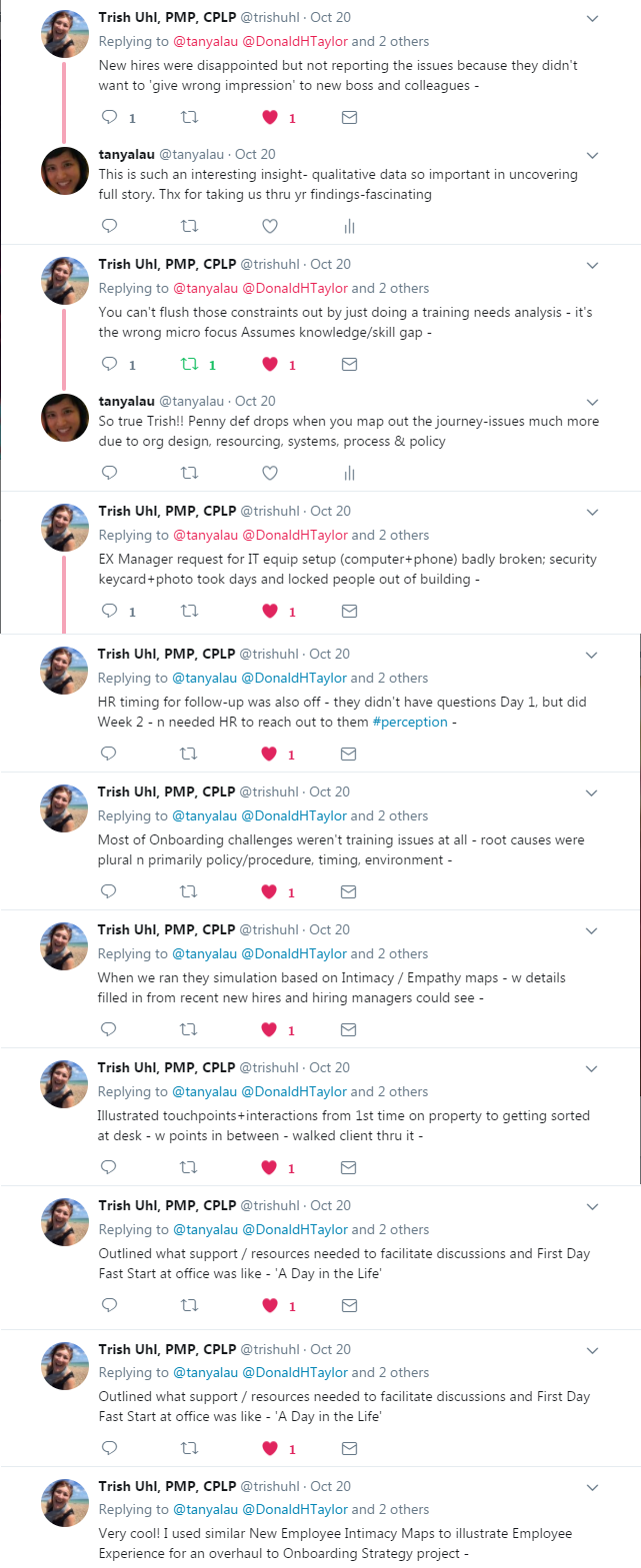This is the first in a couple of posts that charts my experience using the concept of customer journey maps to map an employee experience….in order to identify all of the organisational factors impacting that experience, and more effectively identify and target learning and performance issues that have the biggest impact on improving it.
This post provides some context on what experience or journey maps are, why you would use them, and some background on the problem I was trying to address with my employee experience map.
What are customer journey maps?
Customer journey maps are essentially a visual narrative of a customer’s (or employee’s) experience, as they move through the various phases or touchpoints of that experience – not just what they’re doing, but also who or what they’re interacting with, how they’re interacting, what they’re thinking and feeling during each interaction.
It is a ‘design thinking’ tool that enables you to more deeply understand and empathise with the customer or employee. They look something like this:



Why use customer journey mapping in organisational learning and development?
I think Designing CX expressed it well in their awesome slideshare on employee experience mapping:

In short: because we’re in the business of behaviour change. We know there is a relationship between attitudes and behaviour (the exact direction of which is contestable..but that’s a conversation for another day). Behaviours shape experiences which in turn impact attitudes ….which impact behaviours. It’s a feedback loop. And all of this impacts results (i.e. through individual performance -> which leads to business outcomes).
What can an employee experience map tell us that a training needs analysis can’t?
By looking holistically at the experience, you are able to identify all of the organisational factors (process, environment, people, timing, organisational design…in addition to any training need or issue with learning resources) that impact the employee experience. This enables you and the organisation to focus on fixing the things that truly have the biggest impact on improving the experience – rather than assuming that it’s the training that needs attention. Or, if there are aspects of training or learning resources that are impacting the experience – to identify specifically what these problems are – in order to find the most appropriate solution.
Here are some insights on what can be uncovered from Trish Uhl , who created similar employee intimacy maps to chart the new employee experience when overhauling an onboarding program:

My journey with employee experience mapping
I first heard about the idea of using customer journey mapping to design better employee experiences about a year ago via LinkedIn, through this HBR article and, around the same time, this customer journey mapping toolkit – shared in the LinkedIn Design Thinking Group. I filed it away as something interesting to explore…and recently had a good opportunity to experiment and apply the mapping concept in the Analysis / Discovery phase of a project to better support our bus drivers in learning new bus routes.
Context & background
The organisation knew route familiarisation was an existing problem, and an increasing one with ongoing network changes and introduction of new routes. Lots of ideas had previously been discussed, there were already a number of business initiatives in play to address it, as well as a proposal to explore the use of 360 video (via VR, web, and/or mobile). I’d had some initial conversations with people from various areas of the business to understand the current state.
Why I decided to map the employee experience
It felt like everyone agreed there was a problem, there were a lot of ideas and solutions proposed, but not a great deal of clarity what each solution was really trying to fix.
Objectives I wanted to achieve by mapping the current employee experience were:
- to better understand what the challenges and pain points for employees were, and when and where the biggest issues were occurring -> this would enable us to more precisely define the problem we were dealing with, and pinpoint where we could make the biggest impact with learning, performance or organisational support
- to start to identify what types of solutions or support might be most appropriate at various points of the employee journey -> to enable us to utilise the right resource at the right time. We already have a number of existing resources, initiatives in development, and a bunch of other proposed ideas to explore as ‘solutions’ to the problem. Rather than take a scatter gun approach of offering a whole load of support resources and hoping for the best, I wanted to encourage a more considered and intentional approach. Through my initial conversations, I knew that each resource had different benefits and constraints for drivers, and rather than being a problem that would be solvable through a single solution, a mix of new and existing resources would still be needed – as the problem to be addressed was both in initial learning / training and easy access to accurate ongoing (and ideally on-job) performance support.
- as a way of visually summarising what we currently know to provide more clarity about the problem (from the employees’ view), and to enable all stakeholders to develop a shared understanding and a common view of the issue/s as we move forward with a number of concurrent initiatives to try to resolve it. Incidentally, the motivation for creating the employee map was to provide context to an external supplier we’re working with to explore 360 video / VR possibilities. It is the type of user research they normally would undertake but that was out of scope for the engagement they quoted on.
- support and extend my own development by experimenting with design thinking techniques in a real world work situation – I’d been exploring design thinking concepts for a while, and have for several years taken a user approach to prototyping and testing but wanted to extend this to the analysis / discovery phase.
In the next post I’ll describe the process I took, including the research, useful resources, how I approached it, and outcomes. Read Part 2.
3 thoughts on “Using employee experience journey mapping to identify and target learning and performance issues – part 1 (what & why)”